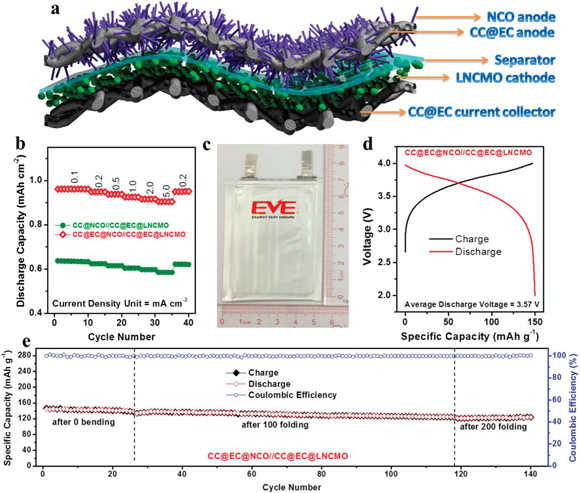New Progress Made by Electrochemistry Group of School of Chemistry in the Application of Core-Double-Shell Electrodes Materials in Achieving High Energy Density Flexible Li-Ion Batteries
Source: School of Chemistry
Written by: School of Chemistry
Edited by: Wang Dongmei
Due to its high energy density and other advantages, flexible li-ion battery has a broad application prospect in the field of flexible wearable electronic equipment. However, how to design and prepare high-performance energy storage electrode materials and how to develop flexible li-ion batteries still face scientific challenges.

Properties of the flexible lithium ion battery. (a) Schematic representation of the flexible device. (b) Rate performance of AFLIBs based on CC@NCO and CC@EC@NCO anodes and CC@EC@LNCMO cathode. (c) Optical image of the CC@EC@NCO//CC@EC@LNCMO FLIB. (d) Charge/discharge profile of the CC@EC@NCO//CC@EC@LNCMO AFLIB at applied current of 5 mA. (e) Cyclic performance of CC@EC@NCO//CC@EC@LNCMO AFLIB at different folding numbers.
Recently, Professor Yexiang Tong of the School of Chemistry and Professor Zhao-Qing Liu of Guangzhou University made a breakthrough in the design of flexible li-ion battery negative electrode materials, with carbon fabric treated with etching and stripping as the substrate (CC@EC), and the growth of NiCo2O4(NCO) nanowire arrays by hydrothermal method. When used as anode materials for lithium ion battery, the lithium storage performance of exhibits excellent performance. Through the DFT calculation, the authors found that NCO and CC@EC have a strong electronic interaction and a lower reaction energy barrier in the lithium ion transport process. In addition, the author further elucidated the contribution factors of CC@EC substrate to the improvement of lithium storage performance of electrode materials through in-situ Raman spectra analysis. On this basis, a fully flexible lithium ion battery (with a total weight of 281 mg) with high energy density (314 Wh/kg) is obtained, which has excellent flexibility, good energy storage performance and opening a new direction for future portable energy. The work has been published in top international journal, Energy Environ. Sci., 2018, 11, 1859-1869. IF = 30.067), titled "Achieving High Gravimetric Energy Density for Flexible Lithium Ion Batteries Facilitated by Core-Double-Shell Electrodes". Muhammad-Sadeeq Balogun (Postdoctoral fellow of the School of Chemistry, Sun Yat-sen university) and Yang Hao (2015 doctoral student) were the co-first author of the paper, and the School of Chemistry, Sun Yat-sen University was the first affiliation.
The above research work has been supported by the National Key Research and Development Program of China, the National Natural Science Foundation of China, China Postdoctoral Science Foundation, the Fundamental Research Funds for the Central Universities, the Science and Technology Plan Project of Guangdong Province and the Science and Technology Plan Project of Guangzhou, China.
Article link: http://pubs.rsc.org/en/content/articlelanding/2018/ee/c8ee00522b
